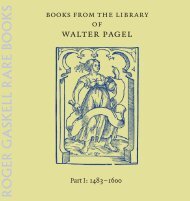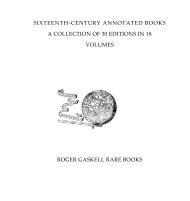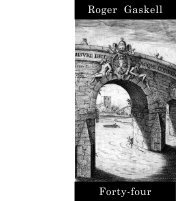pdf - Roger Gaskell Rare Books
pdf - Roger Gaskell Rare Books
pdf - Roger Gaskell Rare Books
Create successful ePaper yourself
Turn your PDF publications into a flip-book with our unique Google optimized e-Paper software.
79<br />
HARTLIB, Samuel (d. 1662)<br />
Chymical, medicinal and chyrurgical addresses made to Samuel<br />
Hartlib.<br />
London: printed by G. Dawson for Giles Calvert at the Black-spread Eagle<br />
at the West End of Pauls, 1655.<br />
8vo: A4 B– L8 8<br />
* † 4 , 96 leaves, pp. [8] 181 (i.e. 159, 78–79, 115–132<br />
and 174–175 omitted) [25]. Divisional title ‘A short and easie method<br />
of surgery... newly translated out of Dutch, 1654’ on K2.<br />
129 x 80mm. Titlepage heavily soiled and with the corner restored<br />
with loss of 2 letters; a few page numbers, signatures and catchwords<br />
shaved or cropped; Wrst line of divisional title shaved; some minor<br />
worming in the blank margins; brown stain in lower outer margin at<br />
the beginning of the book. After the titlepage a good fresh copy.<br />
Binding: Eighteenthcentury mottled sheep, unlettered spine with gilt<br />
bands. Joints cracked.<br />
Provenance: Nineteenthcentury armorial bookplate of Geroge F.<br />
Cartwright.<br />
First edition. Turnbull 50; Wing C3779; ESTC R209495; Fulton, Boyle [1].<br />
This very rare book includes Robert Boyle’s Wrst published work, ‘An invitation<br />
to a free and generous communication of secrets and receits in Physick’ (pp.<br />
113–150), headed ‘Philaretus to Empyricus’ and signed ‘Philaretus’.<br />
In the years leading up to the foundation of the Royal Society in 1660,<br />
Hartlib’s initiative in promoting the exchange of scientiWc information was<br />
inXuential, and was eagerly followed by Boyle. ‘His essay was composed very<br />
much in the spirit of Hartlib’s demand for the completely free distribution<br />
of intelligence on all matters. Boyle argued on both practical and theological<br />
grounds for the free communication of newly discovered chemical remedies.<br />
He asserted that by preserving cryptic language and oaths of secrecy, the<br />
chemists could never be certain of the quality of their discoveries or ensure<br />
the survival of their work in future generations.’ (Charles Webster, The Great<br />
Instauration, 1975, p. 304).<br />
In another contribution to the volume, ‘A Caveat for Alchymists’ (pp.<br />
49–99), Gabriel Platts outlined a scheme for a state laboratory. After Platts’<br />
death Frederick Clodius established a laboratory in Hartlib’s kitchen and a<br />
neighbouring blacksmith’s shop. Plans were also drawn up for a ‘universal<br />
laboratory’, and Hartlib wrote to Boyle on 8 May 1654 asking for his support.<br />
(Webster p. 303). Platts’ essay is prefaced by an address to the reader dated<br />
Westminster, 10 March 1643.<br />
The full list of papers is given on the titlepage as follows:<br />
1. Whether the Vrim & Thummim were given in the Mount, or perfected<br />
by Art.<br />
2. Sir George Ripley’s Epistle, to King Edward unfolded.<br />
3. Gabriel Plats Caveat for Alchymists.<br />
4. A Conference concerning the Phylosophers Stone.







